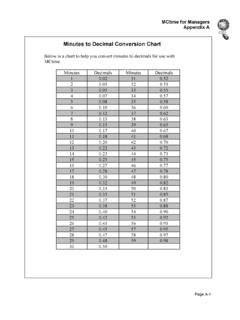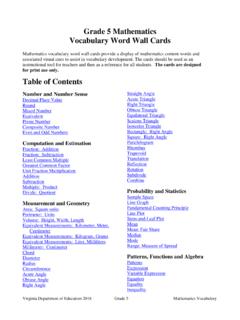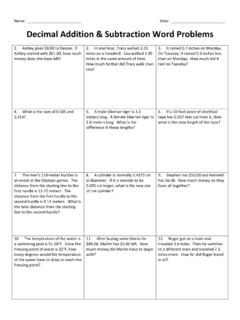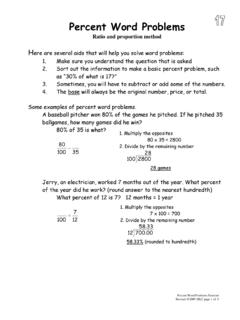Transcription of Psych. 201 Creating APA-Style Tables in Microsoft Word
1 Psych. 201. Creating APA-Style Tables in Microsoft Word A table can be an efficient way of communicating a lot of information in a small amount of space. It should be able to stand on its own, and should not be redundant with material presented in the text of your paper. It is not difficult to create a table in Microsoft Word, but there are a few tricks to making it conform to APA Style. See pp. 125 150 of the Publication Manual of the APA (6th ed.) for sample Tables in APA style. Below are the basic elements of an APA-Style table. The Elements of an APA-Style Table Table number. Tables are numbered with Arabic numerals in the order they appear in the paper. Table title (italicized). The table title should be one double-spaced line below the table number.
2 Capitalize the first letter of major words , and do not end with a period. The title should be descriptive, but succinct. A horizontal line separates the table title from the column headings. Column headings (labels centered over each column). Use upper- & lower-case. A second horizontal line separates the column headings from the table data. Data for your table go next. The table can be double-spaced or not, depending on how much information you need to convey. End your table with a final horizontal line beneath the last row of data. The three horizontal lines listed above are the only three lines you should have in your table. You should not have any vertical lines. (See p. 141 of the APA manual for information about ruling of Tables .)
3 Table notes go one double-spaced line beneath the final horizontal line. Begin with the word Note (in italics) followed by a period. General table notes are used to explain abbreviations or provide additional information. (See pp. 138 141 of the APA manual for an explanation of general, specific, and probability notes, and how to format them.). A Sample Table Below I will walk through an example for a simple table of means and standard deviations. These data come from a survey distributed in Fall 2007 to Psych. 201 students. As part of the survey, students indicated the number of hours per week they typically engaged in a variety of different activities (schoolwork, physical activity, socializing, watching TV, extracurricular activities, volunteering, and working at a job).
4 First, I need to think about how I want to organize all this information. This is the most important step in Creating a good table. Sketch it out for yourself before beginning. It makes sense to list all the variables down the left-most column, and then have two more columns next to that one, one for the means and one for the SDs. The next page illustrates what the table should look like in APA style. Following it are instructions for how to create it in Microsoft Word. 1 . Table 1. Number of Hours Per Week Spent in Various Activities Activity M SD. Schoolwork Physical activities Socializing Watching television Extracurricular activities Volunteering Working (job) Note. Schoolwork was defined as time spent doing class work outside of regular class time.
5 How to Create the Table in Microsoft Word First, go to Table, and choose Insert Table. You will see the following dialog box: Enter the correct number of columns and rows. I chose 3. columns (one for the variable name, one for mean, one for SD). and 2 rows (one for the header row, and one for the data). If you're not yet sure how many rows you need, it is easy to add or delete rows later by highlighting your table, going up to the Table menu, and choosing Insert rows above, Insert rows below, Delete rows above, or Delete rows below. You can also add or delete columns in the same way. You will now get the basic table shown below: 2 . Obviously, this table is not in APA-Style format. In APA style, Tables should have only horizontal and no vertical lines.
6 To fix the table rules, go to View, then Formatting Palette. When the formatting palette appears on the screen, click the arrow next to Borders and Shading. Highlight all the cells in your table, click the arrow next to the border Type on the formatting palette, and choose the picture without lines. Then highlight each row in your table that requires a table rule, and select that type of line from the Type list of possibilities. Your table should now look like this: Now you are ready to begin entering your variable names and data into the table. Just place the cursor into the table cell and type. Tab to move to the next cell in the table. Be sure to double-space everything. Below are a few handy tips: Use the centering function (under Alignment and Spacing on the formatting palette) to center your table headers.
7 Left-align the variable names in the left-hand column. Note that you should never try to space anything using the space bar (the eyeball method). Even if it looks correctly aligned on the screen, it will not be correct when you print the table out. Be sure to align your numbers by the decimal point. To do so, first go up to View and choose Ruler . You should now see the ruler at the top of the screen. Select the appropriate table columns by highlighting them, and go up to the top left-hand part of the screen, where the various tabs are displayed (see below): Choose the decimal tab, as illustrated here. Now click on the ruler where you want the decimal tab to appear ( , in the center of the column). Doing so for one column will place that tab in the same spot in all highlighted columns.
8 Now, when you type numbers into the table, they will align automatically. That should get you started! Remember that you can always use the Help function in Microsoft Word if you run into trouble. 3.












